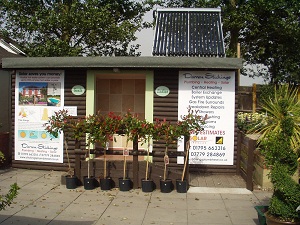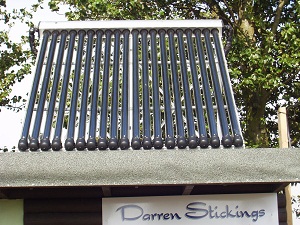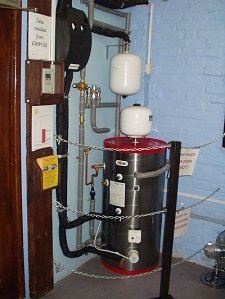

What is Solar Thermal?
Solar Thermal is a clean and highly efficient means of using renewable energy
from the sun to provide the hot water used in the home. The basic principle is
easy to understand. If you unroll a garden hose on the ground and leave it
exposed to the radiant heat of the sun, in a short time the water in the hose
will become warm. Solar thermal collectors work in very much the same way, only
more efficiently. Usually, but not exclusively, roof mounted solar collectors
will be connected to one of the coils of a twin-coil cylinder using a sealed
circuit containing a special glycol/water solution. This fluid not only
withstands the high temperatures in excess of 200ºC on a summer day but also
will not freeze in temperatures down to –25ºC. The pump in the system circulates
the heated fluid from the panel to the cylinder where the heat is transferred to
the stored water through the lower coil.
Why install Solar Thermal?
Solar thermal technology is the most reliable, efficient and accessible form of
renewable energy available today and when combined with Grant's high-efficiency
Vortex Condensing Boiler, annual fuel bills can be dramatically reduced. As
solar water heating depends on radiation, not direct sunlight, it even works on
dull days. Installing Grant Solar collectors can help reduce heating bills by
providing up to 70% of a household's domestic hot water requirements per annum.
Solar thermal is also great for the environment, as it has no emissions and is
assured for the next 4 billion years.
Free Energy
Many people believe that solar panels only work in the summer, however this type
of free energy is available throughout the year. From May to September Solar
Thermal can produce 100% of the energy required for heating your domestic water.
Solar Thermal collectors operate not just with direct sunlight, but also
diffused sunlight, so they even work on cloudy days.
On average Solar Thermal can provide up to 70% of your hot water needs per year,
for free!
Solar radiation in the UK
The diagram below shows the total average solar radiation falling on 1m2
surface, inclined at 30° to the horizontal, measured in kilowatt-hours. The
average property requires approximately 3,000 kWh per year for domestic water
heating.
Solar coverage per month
This graph shows the approximate available solar yield in m2 per month for the
UK.
Roof inclination and direction
When choosing a system there are a number of factors to consider. Almost any
roof type is suitable, however a south facing arrangement could gain 100% of the
light available during the day. If the roof was to face South-East or South-West
there will be a reduction in yield by 5-10%. Collectors can be mounted with an
inclination of between 20° and 90°. As shown in the graph below, optimal
collector performance is achieved on a south facing roof at an angle of 45°.
Evacuated solar hot
water panel
These top-of-the-range solar panel heat collectors are suitable for heating
domestic hot water, swimming pools etc - even in the winter! also known as a
Vacuum hot water panel. One unit is adequate for an average household (3-4
people), and it is modular, so you can add more if required. A single panel is
sufficient for a 200 litre cylinder, but you can fit 2 or more for high water
usage, or for heating swimming pools or under-floor heating. Some types of
renewable energy are only available in certain locations, however free solar
heating is potentially available to almost every house in the UK!

The vacuum tube solar panel has been around for over 10 years, and has proved to
be reliable and dependable. The vacuum tubes consist of a double wall glass tube
(made from strong borosilicate glass ie pyrex) with a space in the centre which
contains the heat pipe. The sun's radiation is absorbed by the selective coating
on the inner glass surface, but prevented from re-radiating by the silvered
innermost lining. This is in effect like a one-way mirror which has been
optimised for infra-red radiation. In fact it is very efficient, of the sun
light's energy hitting the tube's surface, 93% is absorbed, whereas only 7% is
lost through reflection and re-emission. The presence of the vacuum wall
prevents any losses by conduction or convection - just like a thermos flask. The
system will work even in very low temperatures, unlike traditional flat plate
collectors. Our system can be used to heat up water at the South Pole Antarctic
Science Base - where ambient air temperatures can drop below -40°C
The heat transferred to the tip of the heat pipe is in turn transferred to a
copper manifold in which water circulates to heat the domestic hot water tank.
If a tube were placed in direct sunlight on a summer day, the tip temperature
could reach 250°C - the system easily heats domestic hot water cylinders to 60°C
even in cooler weather! The manifold is well insulated with a 2" thickness of
pre-formed rockwool to retain heat and avoid heat loss.

My installations
I combine a range of components from a number of different high quality manufacturers to produce a custom optimised system for every situation. Some of the manufacturers I use include:



This solar system is helping produce hot water to the toilet block and cafe at Stonnes Garden Cenre, Halfway Road, Sheerness. Call in and see a full working display.
Solar can also be installed on combi boilers.
If a job's worth doing, it's worth doing well